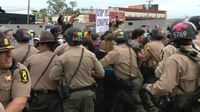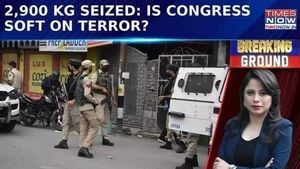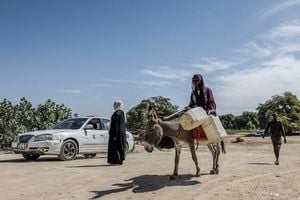On the streets of suburban Chicago, the air is thick with tension, tear gas, and the clamor for accountability. Over the past week, a simmering standoff between federal agents and immigration protesters reached a boiling point, prompting a federal judge to push for sweeping changes in how law enforcement interacts with demonstrators. The heart of the matter? Body cameras—those small, much-debated devices that have become a symbol of transparency and, some hope, a check on unchecked power.
It all began in earnest on October 14, 2025, when images and viral videos surfaced showing federal agents, including Border Patrol officers, deploying tear gas on crowds gathered outside an immigration processing facility in Broadview, Illinois. The footage, which quickly spread across social media and news outlets, showed Illinois State Police—decked out in helmets, face shields, and wielding wooden batons—pushing protesters back from the facility’s gates. The fencing that once ringed the site had been removed, leaving little to separate the two sides.
By the morning of October 17, authorities had detained more than a dozen people at the Broadview facility, according to NewsNation. The location has become a flashpoint, notorious for frequent, sometimes violent clashes between demonstrators and federal agents. For many, the events of that week felt like a culmination of months of escalating tension, especially since the Trump administration’s September launch of “Operation Midway Blitz,” an initiative aimed at deporting undocumented immigrants living in Chicago.
Amid the chaos, U.S. District Court Judge Sara Ellis stepped into the fray. On October 16, she expressed her profound concern over the conduct of federal agents, citing the viral videos and reports of tear gas being used against protesters. According to the Chicago Tribune and Axios, Ellis was “startled” by the images of clashes and felt compelled to act. She modified an existing temporary restraining order, stating her desire—if not yet a formal directive—that all Immigration and Customs Enforcement (ICE) officers and Border Patrol agents involved in Operation Midway Blitz wear body cameras and keep them activated during their operations.
“I believe it’s a fantastic judgment,” Chicago alderperson Jessie Fuentes told Axios, referencing the judge’s decision to modify the restraining order. Fuentes, who was handcuffed earlier in the month by DHS agents after requesting a judicial warrant for a man in her ward’s hospital, added, “These body cams will allow us to ensure that the real story is being told, that there’s transparency now. Will Donald Trump and DHS follow the law? Well, that’s to be determined.”
But the legal waters remain murky. While multiple outlets reported that Judge Ellis had issued a formal order, the Department of Homeland Security (DHS) denies any such directive is officially in effect. The court’s docket, as of October 16, shows only that Ellis modified the restraining order—without spelling out the specifics. A hearing is set for Monday, October 20, for all parties to submit proposed modifications and for Chicago’s ICE field director to explain how the agency will comply with the ruling.
The confusion hasn’t dampened the demands for accountability. A coalition of Chicago journalists, advocacy groups, and protesters filed a lawsuit against the Trump administration earlier in October, alleging a “pattern of extreme brutality” by federal agents at local ICE facilities. Judge Ellis had previously ruled that agents could not target journalists and protesters with riot control weapons—a decision that, in light of recent events, seems more urgent than ever.
On the other side, the federal government has pushed back. An attorney for the Justice Department argued during Thursday’s hearing that not all officers are equipped with body cameras and pointed to the ongoing government shutdown as a significant barrier to immediate compliance. DHS spokesperson Tricia McLaughlin told Axios, “DHS will continue to oppose all efforts to vilify law enforcement and prop up the cause of violent rioters. Were a court to enter such an order in the future, that would be an extreme act of judicial activism.”
Still, the push for body cameras has garnered support from state officials. Illinois Governor J.B. Pritzker, a vocal critic of the deployment of federal agents to his state, praised Judge Ellis’s ruling. “The idea that there’s any justification for people tossing tear gas in the context of people’s protests, I think the judge reacted to that properly by ordering that now the federal agents are required to have body cameras on them because they clearly lie about what goes on,” Pritzker told NewsNation.
Yet, not everyone is convinced that the cameras will bring about meaningful change. Outside the Broadview facility, protesters expressed skepticism. “Do body cameras even matter at this point when no one is being held accountable for any of their actions? When they are allowed to just blatantly lie, you know, and get away with it,” said Demi Palecek, president of Chicago’s 46th ward Democrats, in an interview with NewsNation. It’s a sentiment echoed by many on the ground—body cameras may capture the truth, but will that truth lead to justice?
There’s also the practical question of implementation. While ICE began deploying approximately 1,600 body cameras to officers involved in enforcement and removal operations last year, not all agents have them yet. Other Homeland Security agencies, such as Customs and Border Protection, already require some agents to wear cameras. But the gaps in coverage—and the lack of a clear, enforceable mandate—leave plenty of room for uncertainty.
The legal battle is far from over. Earlier in October, a judge temporarily blocked the Trump administration’s deployment of roughly 500 National Guard troops to protect ICE officers and federal property in Chicago, citing concerns over the use of military force in civil law enforcement. The White House has signaled its intent to appeal the ruling and has hinted at the possibility of invoking emergency powers to push its agenda forward, should court rulings stand in its way.
Meanwhile, another weekend of protests is planned outside the Broadview ICE processing facility. Local police told NewsNation they are relying on the new body camera requirement and tighter crowd restrictions, imposed by the village mayor, to help keep tensions in check. Whether those measures will be enough to prevent further violence—or to restore public trust—remains an open question.
As the city braces for more demonstrations, the debate over body cameras encapsulates a broader struggle: the demand for transparency, accountability, and the right to protest in an era of heightened political and social division. For now, all eyes are on Monday’s court hearing, where the next chapter in Chicago’s fight over immigration enforcement and civil liberties will unfold.




